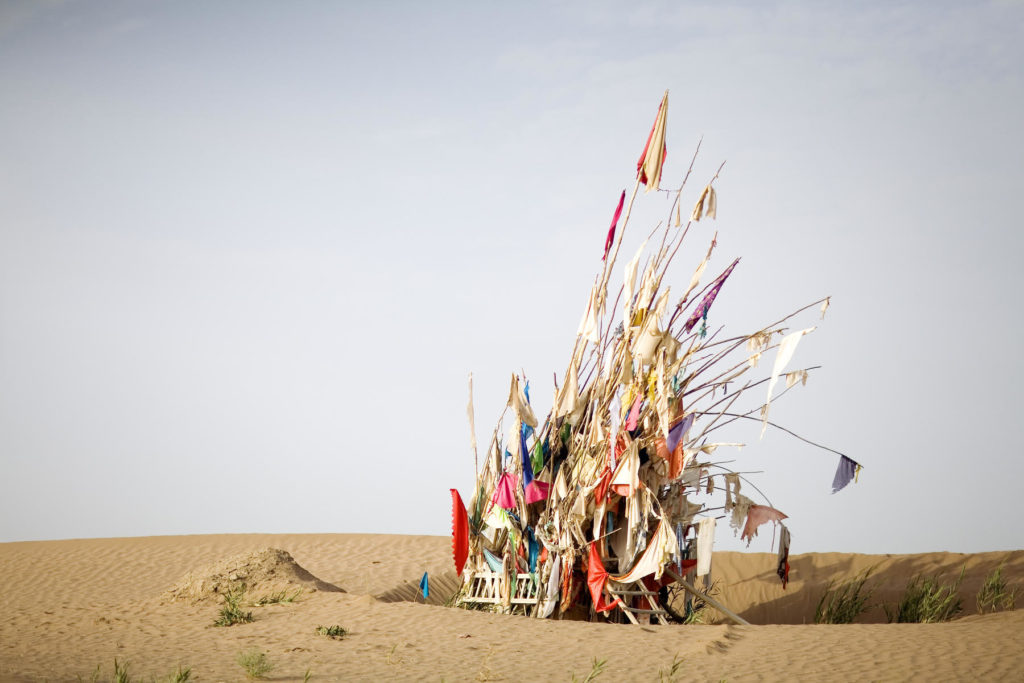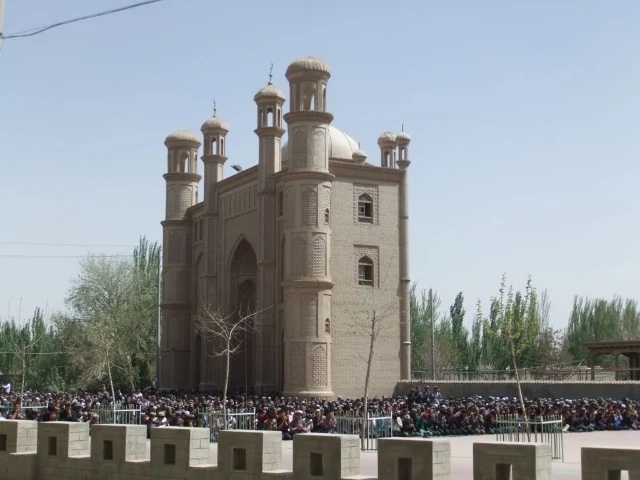
Over the past few years, government authorities in the Xinjiang Uyghur Autonomous Region of China have destroyed large swathes of the religious heritage of the Turkic Muslim Uyghurs. This campaign of demolition has proceeded in tandem with the heavy securitization of the region, mass incarcerations, and attacks on the Uyghur language and other aspects of their cultural identity. Although China has justified these moves as necessary to counter terrorism, its actions arguably amount to what UNESCO calls “strategic cultural cleansing”: the deliberate targeting of individuals and groups on the basis of their cultural, ethnic, or religious affiliation, combined with the intentional and systematic destruction of cultural heritage. This attempt to remodel the region’s cultural landscape is impelled by the strategic and economic objectives of the Belt and Road Initiative (BRI), Xi Jinping’s keystone policy introduced in 2013, which aims to secure access to the region’s natural resources and transform Xinjiang into a platform to expand China’s influence and trade across Asia.
Over the past two decades, China has become a key player in the international heritage sphere, and has developed its own unique approach to heritage management. Cultural heritage is linked to political goals. It serves as a resource for political legitimacy and soft power and is used as an asset to boost local economic development. China’s leading role in inscribing the Silk Road on UNESCO’s list of World Heritage Sites in 2014 demonstrates how it positions itself as an international heritage leader and how closely its heritage strategy is aligned with its economic and political goals.
In Xinjiang, the management of Uyghur cultural heritage has been tightly tied to government attempts to deepen control over the region. The Xinjiang government has used Uyghur heritage as a cultural resource to develop the tourism industry. Tourism initiatives are typically led by Chinese companies, and benefits to Uyghurs have been uneven. The growth of tourism facilitates the movement of Han Chinese into the region, both as short-term visitors and permanent settlers, and provides additional justification for the repressive securitization policies which are deemed necessary to stabilize the region.
Uyghur culture, in the form of the Muqam musical repertoire and Meshrep community gatherings, is strongly represented on UNESCO’s lists of Intangible Cultural Heritage, and numerous items of Uyghur religious heritage—mosques and shrines—are included on China’s own national and regional heritage lists. Although recognized heritage sites should be protected under national laws, over the past few years thousands of mosques and shrines, including protected sites, have been fully or partly demolished. China argues that government management of Uyghur culture is necessary to protect it from religious extremism. In fact—as evidenced by the large-scale destruction of sacred sites, prohibitions on Uyghur language and literature, and disruption of Uyghur communities since 2017—the biggest threats to Uyghur heritage and culture are the policies of the Chinese government itself.
Mosques, Shrines, and the Transmission of Uyghur History
Up until the 1950s, when the Xinjiang region was incorporated into the Peoples’ Republic of China, religious institutions were central to social and economic life. In the early 1950s, Kashgar region alone had 12,918 mosques. The major festival mosques were the site of mass celebrations at the festivals of Eid and Qurban. Madrasahs (religious schools) provided the main source of formal education for Uyghur boys. The most distinctive and significant aspect of religious life centered around the shrines—tombs of martyrs and saints—which were popular pilgrimage destinations and held their own festivals celebrating the saints.
The spread of Islam into this region started in the tenth century with the conversion of the rulers of the Turkic Qarakhanid dynasty and their conquest of neighboring Buddhist kingdoms. Sufi orders played an important role in the introduction of Islam. Sufi sheykhs were respected as community leaders, and venerated for their spiritual powers. Revered in life as well as in death, the shrines of these historical leaders and saints became important sites of pilgrimage. These saints and their shrines have played a crucial role in the culture and history of the region.
Most of these shrines are not major architectural monuments. Some of the most important shrines are simple mud brick constructions, distinguished visually by the huge temporary structures made up of “spirit flags” which are brought by pilgrims and attached to the shrine or tied together in tall flag mountains.
Religious Revival and “Strike Hard” Campaigns
In the wake of the Cultural Revolution, and with the relaxing of controls on religious life, Uyghurs began to return to their faith, and new forms of piety began to permeate Uyghur society. These trends mirrored revival movements across post-Soviet Central Asia and Hui Muslim Chinese communities. During my visits to the region over the past twenty years, I saw many people returning to family traditions of prayer, fasting, and modest dress; sending their children to Qur’an school, saving money to go on the hajj. An important aspect of the revival was the building or reconstruction of community mosques. Local communities and individual donors raised money to build impressive structures that reflected a renewed pride in the faith, and new community confidence and prosperity.

Already by the 1990s, the Xinjiang authorities were viewing these developments with deep suspicion. A series of “strike hard” campaigns began to target religious life. Everyday practices, such as daily prayer and fasting, veiling or growing beards, were criticized as antisocial. Activities central to Uyghur culture, including shrine pilgrimage and religious instruction of children, were designated “illegal religious activities.”
Soon after the US announcement of a “Global War on Terror,” China began to adopt the rhetoric of religious extremism and terrorism, drawing on internationally circulating tropes of Islamophobia to justify its actions against the Uyghurs and other Turkic Muslim minorities: actions which were increasingly taking the form of cultural cleansing. Activities previously designated “illegal religious activities” were now dubbed “religious extremism.” State media began to designate local incidences of violence as “terrorist incidents” although the specific reasons underlying local violence were more often to do with local power struggles, official corruption, and police brutality.
In May 2014, the recently appointed President Xi Jinping called for the construction of “walls made of copper and steel” to defend Xinjiang against terrorism. Uyghurs’ passports were confiscated, ties with the outside world were cut off, a tight net of surveillance tracked their every movement, and construction began on the system of mass internment camps.
The “Mosque Rectification” Campaign
Rather than targeting the small number of people who might reasonably be judged vulnerable to radicalization and violent action, the anti-religious extremism campaign in Xinjiang targeted all expressions of Islamic faith, and it removed swathes of Islamic architecture from Uyghur towns. Beginning in 2015, and greatly accelerating in 2017, the Xinjiang authorities demolished thousands of mosques under a “mosque rectification” campaign. Many were condemned on the grounds that they were unsafe structures that posed a safety threat for worshippers. Others had their distinctive architectural features, such as domes and minarets, removed. All of this formed a part of the national campaign to “Sinicize” religion, introduced under Xi Jinping to implement his vision of Chineseness as narrowly centred on Han Chinese culture, with “foreign” religious influences increasingly regarded as a threat to stability.
Recent investigations have provided extensive evidence of the demolition or modification of thousands of Uyghur mosques and several shrines (using satellite imagery to verify each site). Not only was the built heritage destroyed. Rahile Dawut, a Uyghur academic who had dedicated her life to documenting the shrines, was detained shortly before the demolitions in November 2017, one among hundreds of disappeared intellectuals and cultural leaders. She remains in an internment camp at the time of writing.
Many Uyghur cemeteries were also destroyed or relocated during this period. The extremely rapid program of removing human remains and bulldozing structures left local people (even if they were not incarcerated in the camps) scant time to reclaim the bones of their family members. Important historical shrines have been destroyed along with the cemeteries. Khotan’s Sultanim Cemetery, for example, has a history of over 1,000 years. It contained the shrine of the Four Sultans, an important pilgrimage site, and many other significant figures in Khotan’s history were buried in this cemetery. In March 2019, disinterment notices appeared around the city of Khotan, warning that the cemetery would be demolished within three days. According to satellite images, the site was completely flattened by April 2019, and part of the cemetery appeared to be in use as a parking lot.
Although the authorities have tried to justify the destruction or relocation of cemeteries by the demands of urban development, it is clear that these moves form part of the wider effort to disrupt communities and break the transmission of Uyghur culture. Such projects of development and securitization attempt to remodel the cultural landscape and to re-engineer the desires and actions of its inhabitants. In Xinjiang, this campaign of demolition came hand in hand with the heavy securitization of the region, mass incarcerations, and physical violence inflicted by state forces on Uyghur bodies in the form of enforced sterilization, and documented instances of rape and torture in the camps. Increasing numbers of independent observers and national governments have argued that China’s policies in Xinjiang amount to a deliberate act of genocide. It is important to note that the systematic destruction of cultural and religious heritage—as we have seen with the mosques, cemeteries, and shrines of the Uyghurs—has historically been deployed as a way to weaken the culture and identity of a people, part of a wider strategy of dehumanization which typically paves the way for the physical atrocities which lie at the heart of our understandings of genocide.

